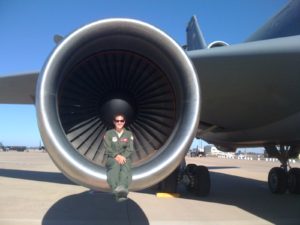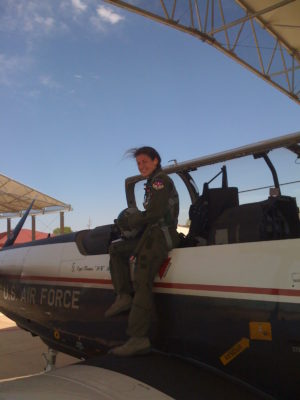 I’m currently working at the Pentagon and am flying the C-32 (a specially configured 757). I fly the top-5 members of our government, including the Vice President, First Lady, Secretary of State, Secretary of Defense, and the Chairman of the Joint Chiefs of Staff.
I’m currently working at the Pentagon and am flying the C-32 (a specially configured 757). I fly the top-5 members of our government, including the Vice President, First Lady, Secretary of State, Secretary of Defense, and the Chairman of the Joint Chiefs of Staff.
WHAT GOT YOU INTERESTED IN AVIATION?
I initially pursued a career in Air Force medicine because I was fascinated by human biology and loved helping people. Luckily, when I was at the United States Air Force Academy, I received a summer internship at Landstuhl Air Base, Germany. During this internship I learned I was happiest when shadowing aircrew members versus medical surgeons. As a result, I set myself up to attend medical school while taking some introductory courses in aviation. Going into my senior year, I was fortunate enough to have the option of attending medical school or pilot training and proceeded to pilot training!
HOW DID YOU GET STARTED FLYING?
When I graduated from the Academy I was matched to become a pilot. The first step was to attend “Introductory Flight Screening” (IFS) in Colorado where I flew the DA-20 and was screened for the aviation skill set. Once I passed IFS, I was matched to a school in Oklahoma where I flew the T-6, the T-1, and got my wings! From there, I flew the KC-10 for 7 years and taught at the KC-10 school house. After my time flying the KC-10, I applied and was selected to fly the C-32.
WHAT WAS YOUR FIRST FLIGHT LIKE?
 My first flight was very similar to my first solo jump out of an airplane. You train for the normal, abnormal, and emergency situations so well that you’re ready. That being said, your heart is racing, your breathing gets deeper, and you think to yourself, “I’m ready, I can do this!” The rest was the feeling of getting pushed back into your seat and enjoying the ride.
My first flight was very similar to my first solo jump out of an airplane. You train for the normal, abnormal, and emergency situations so well that you’re ready. That being said, your heart is racing, your breathing gets deeper, and you think to yourself, “I’m ready, I can do this!” The rest was the feeling of getting pushed back into your seat and enjoying the ride.
WHAT DO YOU LIKE ABOUT FLYING?
The trust you must have in yourself and your team and the freedom you feel when you’re cruising above the clouds.
WHAT’S THE MOST CHALLENGING PART OF FLYING?
The most challenging part of flying is continuing to stay engaged in learning about the aircraft. That means continuing to study, fly to hone your skill set, and accept feedback.
DID YOU ENCOUNTER ANY ROADBLOCKS ON YOUR PATH TO YOUR LICENSES?
 I did! During T-6 pilot training, I had severe motion sickness. So much so, I had to request my friends spin me in the Barany Chair every day I didn’t fly, including the weekends. Despite never getting actively sick in the Barany Chair, my air sickness didn’t improve. I nearly washed out of pilot training due to this motion sickness, despite being able to continue to make radio calls and maintain aircraft control during the episodes.
I did! During T-6 pilot training, I had severe motion sickness. So much so, I had to request my friends spin me in the Barany Chair every day I didn’t fly, including the weekends. Despite never getting actively sick in the Barany Chair, my air sickness didn’t improve. I nearly washed out of pilot training due to this motion sickness, despite being able to continue to make radio calls and maintain aircraft control during the episodes.
On my last allocated “air sickness flight” in the T-6, I flew with a very large, burly instructor who started belting out the Beatles, “Love me Do” as soon as we were airborne. You wouldn’t believe it, but I began laughing so hard, it stopped my air sickness. From then on, every time I felt queasy I started to sing, and the sickness went away.
WHAT ADVICE WOULD YOU GIVE TO SOMEONE WHO WANTS TO PURSUE AVIATION?
My advice would be to find aircrew members, talk to them, get tours of the aircraft, and if you can afford it, fly at least once!
Lastly, and the most important advice I can bestow on anyone is: believe in you. Know you are good enough; you can do this, and whatever roadblocks are in your way you can get through them if not by yourself then with the help of others.

